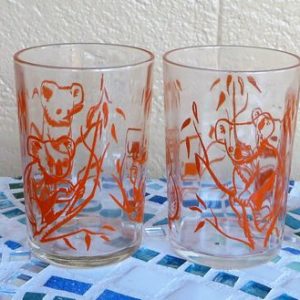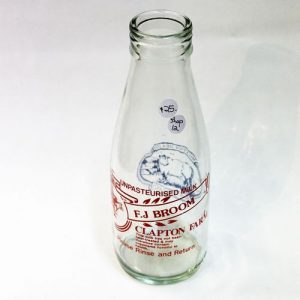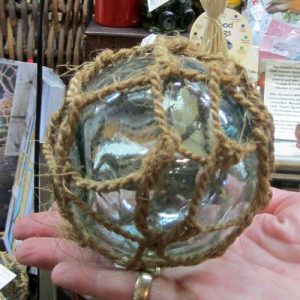Carlsberg Mineral Water Bottles
$195.00
4 in stock
Description
Carlsberg Bottles – two with barely there traces of original labels, featuring meander pattern border, two without labels, measure 21cm in height. Porcelain stoppers are present. They all have flea bite chips to the porcelain – none are perfect, but they are remarkable survivors from 100 years ago. Below is a little history of the company, their original good luck arts & crafts inspired logo. (Taken from mostly Wikipedia & Carlsberg webpages.)
Carlsberg Brewery History
Carlsberg is a Danish multinational brewer. Founded in 1847 by JC Jacobsen the company’s headquarters is in Copenhagen, Denmark. Carlsberg was started by J.C. Jacobsen in 1847 in the streets of Copenhagen, Denmark. J.C. Jacobsen, who was born in 1811, first started brewing larger in his own cellar until he was 36. At this age, he managed to open his own company on a mountain which was a perfect place for the brewery.
Jacobsen named his company after his son Carl and since the brewery stood on a mountain, he added Bjerg, which is a Danish name for mountain. From the first brew in 1847, Carlsberg larger was only distributed to the local citizens. As years passed by, they became very popular in Denmark for their better flavour. So, Jacobsen decided to distribute their products to other countries. Their first export began in 1868 to Edinburg, Scotland. JC Jacobsen was a philanthropist and avid art collector, who was obsessed with music. Jacobson also showed a keen interest in politics and society. All his qualities gave an essence to the company that made it a huge success.
Jacobsen named his company after his son Carl and since the brewery stood on a mountain, he added Bjerg, which is a Danish name for mountain. From the first brew in 1847, Carlsberg larger was only distributed to the local citizens. As years passed by, they became very popular in Denmark for their better flavour. So, Jacobsen decided to distribute their products to other countries. Their first export began in 1868 to Edinburg, Scotland.
J. C. Jacobsen was a philanthropist and avid art collector, who was obsessed with music. Jacobson also showed a keen interest in politics and society. All his qualities gave an essence to the company that made it a huge success.
With his fortune he amassed an art collection which is housed in the Ny Carlsberg Glyptotek in central Copenhagen. Some of the company’s original logos include an elephant, after which some of its lagers are named, and the swastika, the use of which was discontinued in the 1930s because of its association with political parties in neighboring Germany.
Jacobsen’s son Carl spent time in France, Germany, Australia and Scotland for his education, where he gained a good knowledge of beer on his return to home. Carl opened a brewery in 1882 named Ny (New) Carlsberg forcing his father to rename his brewery Gamle (Old) Carlsberg. The companies were merged and run under Carl’s direction in 1906 and remained so until his death in 1914.
Jacobsen set up the Carlsberg Laboratory in 1875, which worked on scientific problems related to brewing. It featured a Department of Chemistry and a Department of Physiology. The species of yeast used to make pale lager, Saccharomyces carlsbergensis, was isolated by Emil Christian Hansen at the laboratory in 1883 and bears its name; this was shared freely by Carlsberg. The Carlsberg Laboratory also developed the concept of pH and made advances in protein chemistry. In 1972, the Carlsberg Research Centre was established and the Carlsberg Laboratory is an independent unit of the Centre.
Since Jacobsen’s death in 1887, the majority owner of the company has been the Carlsberg Foundation. The company employs around 41,000 people, primarily in Europe and Asia. Carlsberg is currently the 6th largest brewery in the world based on revenue.
The old brewery in Copenhagen had a complete refurbishment and restoration in 2020. Tours of the outdoor areas of the factory can be taken today.
Carlsberg Logo
Jacobsen loved art and from the early 1900’s – 1920’s the swastika was part of the arts and crafts movement, used by many cultures in their art design. It was on trend and it was a symbol of peace and a symbol of good luck/fortune. For this reason Carlsberg incorporated it into their logo, which can still be seen today in the Carlsberg old factory main gates, on pavements and ceilings. When the German National Socialist Workers party (NSDAP) began to rise to power in the late 1920’s, firstly with violence & then through political means, using the swastika with a red background as their symbol, Carlsberg decided to change their logo to another symbol – the hop leaf, which also looks to most, a little like another lucky symbol – the clover. The colour then changed to green. This hop leaf logo was used from 1931 and continues today. Carlsberg beer bottles featuring the swastika both on the bottle tops & the base of the bottle, date typically to the early 1920’s, pre Third Reich Era.
Carlsberg During World War I & World War II
The World War I and II were the tough times for the entire world as people all around the world suffered a lot. The Danes were one of them. Not only the beer industry but also all the other industries were at stake during these times. During World War I, 1914 to 1918, Carlsberg had to face several challenges. The production of beer fell by greater amounts due to scarcity of the raw materials required for the production of beer. The export of beer was restricted and the consumption of alcohol was being protested at that time. These factors halted the growth of the beer industries. During the period between the two wars, the sales gradually rose but never to its state before the war.
Again, during the lead up to and during World War II, 1935 to 1945, Carlsberg industry fell due to the scarcity of raw materials, influence of the German empire and the pressure of the war. Exports were only allowed into Germany and at the same time, the sales were low because Germans hesitated to consume alcohol during their service. (Fuhrer/Leader Adolf Hitler was a tea drinker & did not condone the drinking of alcohol.)
After the war, Carlsberg along with Tuborg and Heineken resumed their export to other countries, which they mainly focused on United Kingdom as their major recipient. This gradually increased the trade and Carlsberg started to open new breweries abroad. However, due to the impact of war, Carlsberg took several years to flourish in the market again.
The old brewery in Copenhagen had a complete refurbishment and restoration in 2020. Tours of the outdoor areas of the factory can again be taken today.










